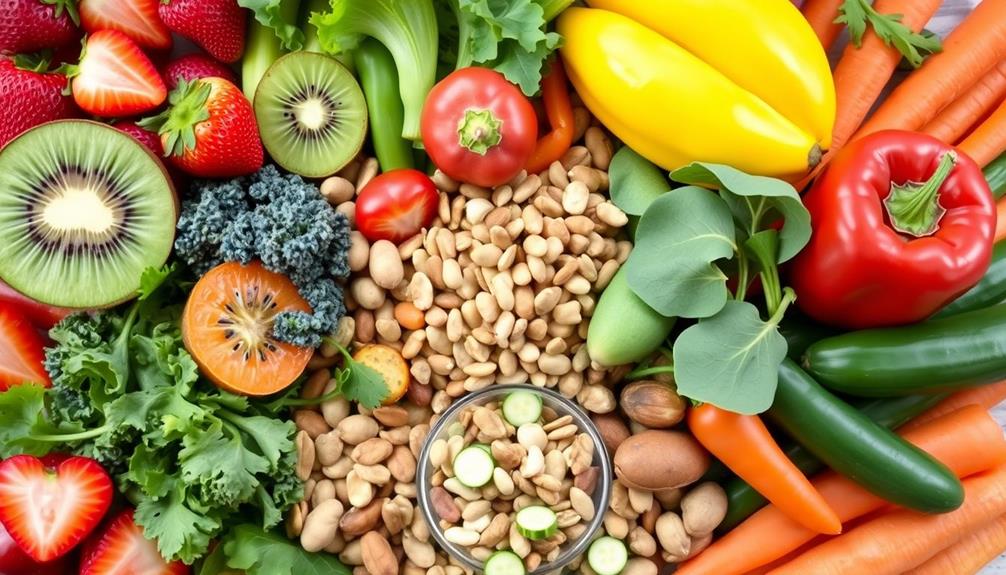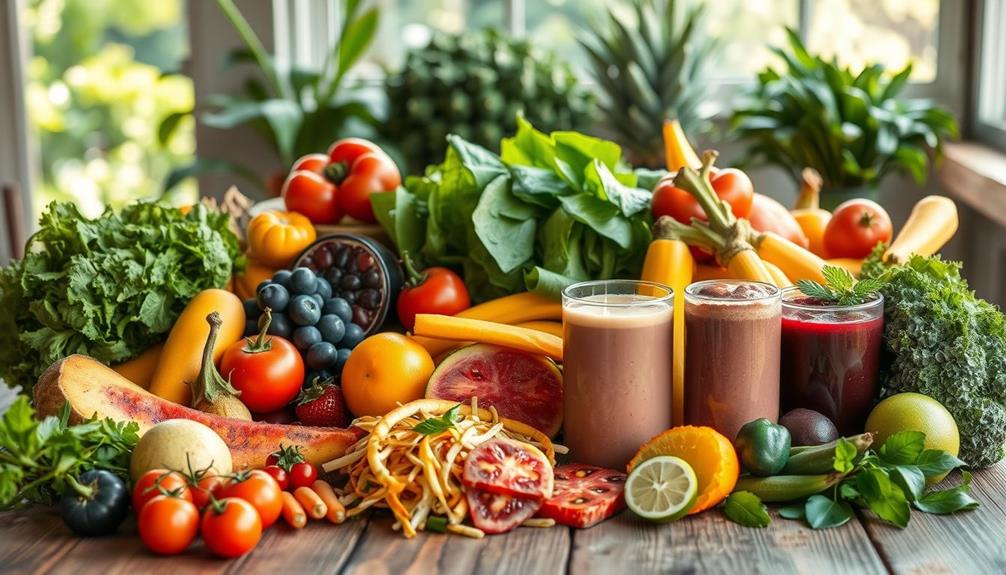Raw food includes a variety of fresh fruits like apples and berries, crisp vegetables such as carrots and greens, and nutrient-rich nuts and seeds. You can also enjoy dried fruits like prunes or raisins, and even edible weeds like dandelion. Algaes like spirulina and chlorella are fantastic superfoods to add for extra protein and nutrients. Fresh herbs and sprouted grains can enhance your meals, too. This wide selection makes it easy to maintain a nutritious diet. If you're curious about more raw food options and tips, there's plenty more to explore!
Key Takeaways
- Fresh fruits like apples, pears, and berries are rich in vitamins and antioxidants.
- Fresh vegetables such as carrots, salad greens, and tomatoes provide essential nutrients and fiber.
- Nuts and seeds, including almonds and sesame seeds, offer healthy fats and protein.
- Dried fruits like prunes and raisins serve as convenient, energy-packed snacks.
- Unique options like edible weeds, algaes (spirulina, chlorella), and fresh herbs enhance nutritional value and flavor.
Common Raw Foods
Common raw foods are a vibrant part of a healthy diet, offering a range of flavors and nutrients. When you explore raw foods, you'll find a treasure trove of plant-based foods that not only satisfy your taste buds but also boost your health. Fresh fruits like apples, pears, and berries are loaded with vitamins and antioxidants, making them excellent choices for snacking or adding to your meals.
Additionally, many raw fruits can provide hydration and support detoxification processes in the body, such as celery juice benefits.
You can't overlook fresh vegetables, either. Carrots, salad greens, tomatoes, and bok choy are staples in a raw food diet, providing essential nutrients and fiber for overall well-being.
Nuts, particularly unroasted and unsalted varieties such as almonds, hazelnuts, and pine nuts, deliver healthy fats and protein, keeping you satisfied and energized.
Seeds like sesame seeds and poppy seeds, along with sprouted varieties, add nutritional benefits, including omega-3 fatty acids and minerals, to your diet.
Dried fruits, such as prunes and raisins, offer a convenient snack option, packed with energy and natural sweetness when free from vegetable oils.
Embracing these common raw foods can lead you to a healthier lifestyle filled with delicious choices.
Easily Accessible Ingredients
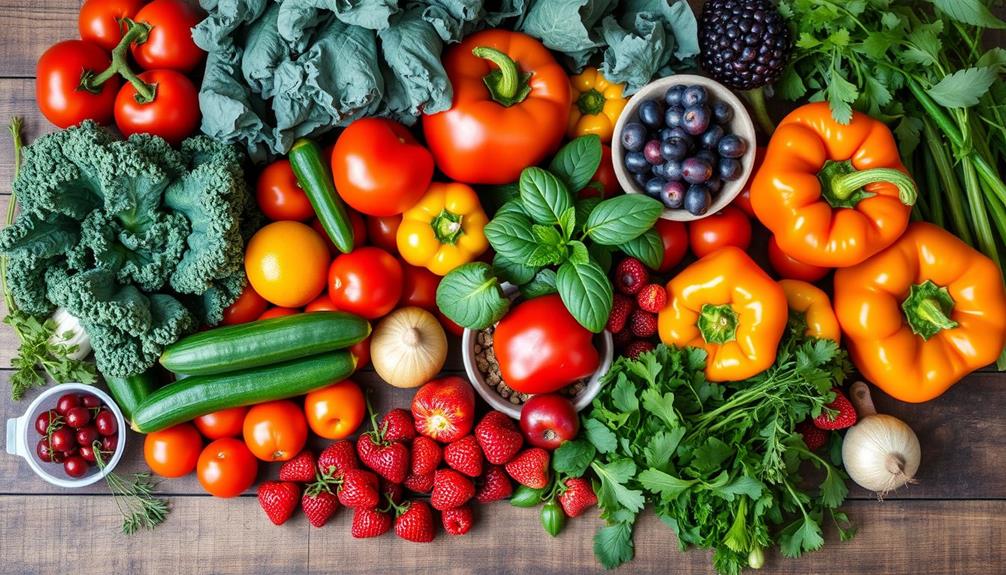
When you're looking to incorporate raw food into your diet, you'll find plenty of easily accessible ingredients right at your fingertips.
Indoor greens like cress and wheatgrass can be grown at home, while dried vegetables and fresh herbs add flavor and nutrients without much effort.
Additionally, consider enhancing your meals with essential oils for flavor and health benefits.
These ingredients not only enhance your meals but also make it simpler to stick to a raw food lifestyle.
Indoor Greens Options
If you're looking to boost your nutrient intake with minimal effort, indoor greens are a fantastic option. They're easy to grow at home or find at local markets, giving you access to fresh, nutrient-dense foods year-round. Here's a quick overview of some popular indoor greens:
| Indoor Green | Health Benefits | Nutrients |
|---|---|---|
| Cress | Fast-growing, peppery flavor | Vitamins A, C, K |
| Wheatgrass | High in chlorophyll, great for juicing | Vitamins A, C, E, iron |
| Sunflower Greens | Mild, nutty flavor, packed with protein | Protein, vitamins B, D, and minerals |
Cress can be harvested in just 7 to 14 days, making it perfect for quick gardening. Wheatgrass is incredibly versatile; you can juice it or blend it into smoothies for a nutrient boost. Sunflower greens not only enhance the taste of salads and sandwiches but also provide essential vitamins and minerals. With minimal equipment, you can grow these indoor greens in small containers, ensuring a continuous supply of crucial nutrients and health benefits.
Dried Vegetables Benefits
While indoor greens offer fresh nutrients, dried vegetables provide a convenient and shelf-stable alternative that can easily enhance your raw food meals. These nutrient-dense options can add flavor, texture, and essential vitamins to your diet, much like how various brewing methods in coffee can influence flavor profiles.
Here are three compelling reasons to incorporate dried vegetables into your raw diet:
- Nutrient Retention: Dried vegetables like carrots and bell peppers retain critical nutrients, such as vitamin A and vitamin C, which are essential for your health.
- Low Calorie, High Fiber: They're typically lower in calories while boosting your dietary fiber intake, promoting better digestion and gut health.
- Antioxidant Power: Ingredients like dried mushrooms not only enhance the umami flavor in salads and dressings but are also packed with antioxidants.
When selecting dried vegetables, be certain to choose those without added oils or preservatives. This way, you maintain their raw food integrity and maximize health benefits.
As always, consult your healthcare professional to guarantee you're getting the right balance of nutrients in your diet. Embrace the convenience of dried vegetables and make your raw meals even more exciting!
Fresh Herb Varieties
Fresh herbs are a fantastic addition to any raw food diet, offering a burst of flavor and a wealth of nutrients. Herbs like parsley and basil not only enhance the taste of your dishes but also provide essential vitamins and antioxidants, boosting your overall health.
For a peppery kick, consider adding cress to your salads and sandwiches; it's packed with vitamin C and grows quickly indoors. Incorporating fresh herbs into your meals can also promote mindfulness and presence, as engaging with food preparation allows for a more intentional eating experience music therapy integration.
Sunflower greens are another great option. They're nutrient-dense and easy to cultivate at home, lending a crunchy texture and mild nutty flavor to your meals. These fresh herbs can also elevate your culinary creations by serving as the base for vibrant dressings and sauces.
By incorporating healthy fats and herbs, you can markedly improve the nutritional profile of your raw dishes. The best part is that fresh herbs are readily available in local supermarkets, making them an accessible and versatile ingredient.
Whether you're adapting to or maintaining a raw food diet, these herbs can easily fit into your meal plans, enhancing both flavor and nutrition. Embrace the variety and health benefits of fresh herbs to make your raw food experience even more enjoyable!
Unique Raw Foods
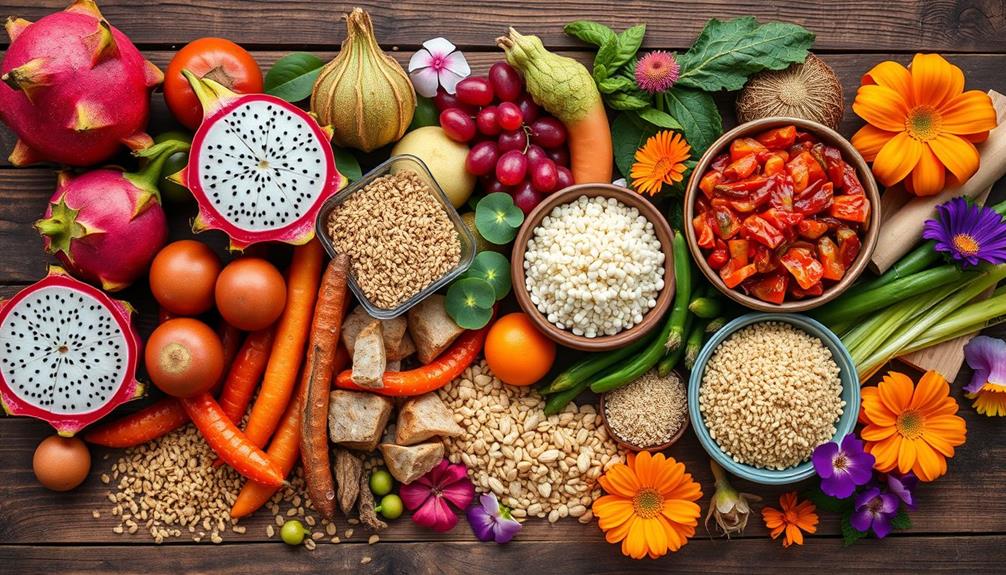
When exploring unique raw foods, you'll find that edible weeds like dandelion aren't only free but packed with nutritional benefits.
Additionally, incorporating essential oils for skin conditions can complement your raw food diet by promoting skin health.
Nutrient-dense algaes, such as spirulina and chlorella, are also fantastic additions to your diet, providing essential proteins and nutrients.
Incorporating these options can elevate your raw meals and enhance your health.
Edible Weeds Options
Edible weeds offer a unique and often overlooked option for those exploring raw food diets. These plants, often found for free in your backyard or local park, can be a cost-effective and nutrient-rich addition to your meals.
Herbal remedies like chamomile and ginger may also complement your raw food diet by helping with relaxation and overall well-being.
Here are three compelling reasons to embrace foraged edible weeds:
- Nutrient Powerhouses: Dandelion greens are loaded with vitamins A, C, and K, along with essential minerals like calcium and iron. These nutrients are essential for your overall health.
- Flavor Enhancers: Edible weeds like purslane and chickweed can elevate your salads and smoothies, adding unique flavors and textures without the need for cooking.
- Sustainable Eating: Foraging for these plants not only connects you with nature but also promotes a sustainable lifestyle by reducing your reliance on store-bought produce.
When you include these edible weeds in your raw food diet, you're not just eating healthy; you're also embracing the adventure of discovering what nature has to offer.
Just remember, proper identification is key to avoid toxic plants. So, grab a guide and start exploring the wild!
Nutrient-Dense Algaes
Exploring unique raw foods also means considering nutrient-dense algaes like spirulina and chlorella. These superfoods pack a powerful punch in nutrition, offering a wealth of benefits that can elevate your raw food diet. Spirulina, with its impressive 60-70% protein content, is brimming with antioxidants and essential vitamins like B12 and K. On the other hand, chlorella is renowned for its detoxifying abilities, loaded with chlorophyll that supports blood health.
You can easily incorporate these algaes into your meals, adding them to smoothies, salads, or raw energy bars. Here's a quick comparison to show what makes them special:
| Algae Type | Key Nutrients | Health Benefits |
|---|---|---|
| Spirulina | Protein, Iron, Omega-3 | Boosts immunity, energy booster |
| Chlorella | Chlorophyll, Vitamins | Detoxification, blood health |
| Both | Antioxidants, Vitamins | Nutrient density, superfood status |
Both spirulina and chlorella are cultivated in strict conditions, ensuring their purity and nutrient density. Embrace these nutrient-dense algaes, and enhance your raw foods experience today!
Optional Superfoods
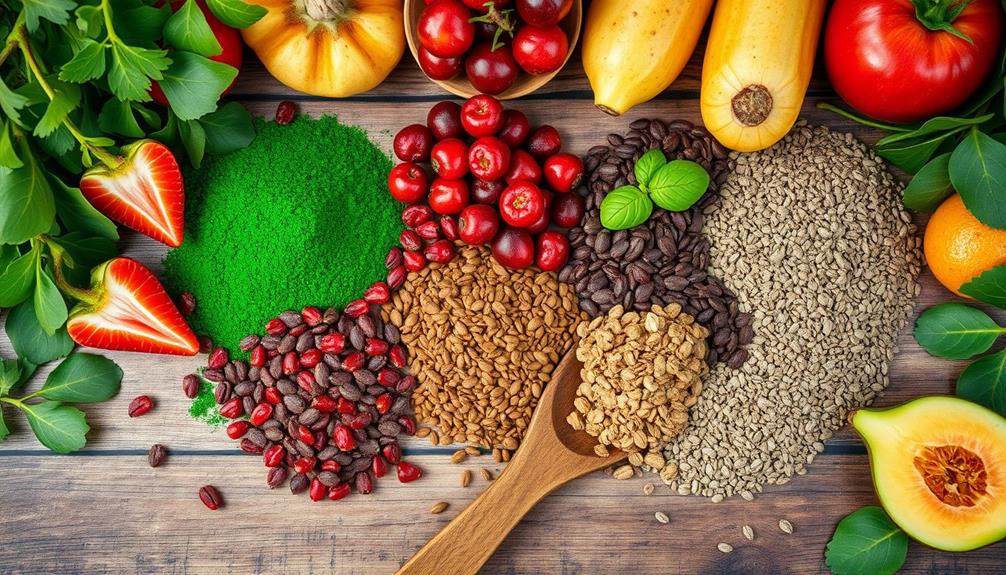
Incorporating optional superfoods into your raw food diet can elevate your meals and provide a wealth of nutrients.
These superfoods not only enhance the flavors of your dishes but also contribute considerably to your overall health. By focusing on a balanced diet rich in whole foods, you can further optimize your nutrition and well-being, similar to the principles of sustainable weight loss.
Here are three must-try optional superfoods to contemplate:
- Nut Butters: Packed with healthy fats and protein, nut butters are a delicious way to boost your energy levels while enjoying raw foods. They make for a convenient snack or a creamy addition to smoothies.
- Sprouted Grains: Foods like sprouted quinoa and alfalfa sprouts are nutrient-dense and improve digestibility. Adding them to salads or wraps can give your meals an extra nutritional punch.
- Bee Pollen: Often hailed as a superfood, bee pollen is rich in vitamins and minerals. Sprinkle it over your desserts or blend it into smoothies for an added health boost.
Incorporating these superfoods into your diet not only enriches your meals but also helps you embrace a more vibrant and health-conscious lifestyle.
Meal Preparation Tips
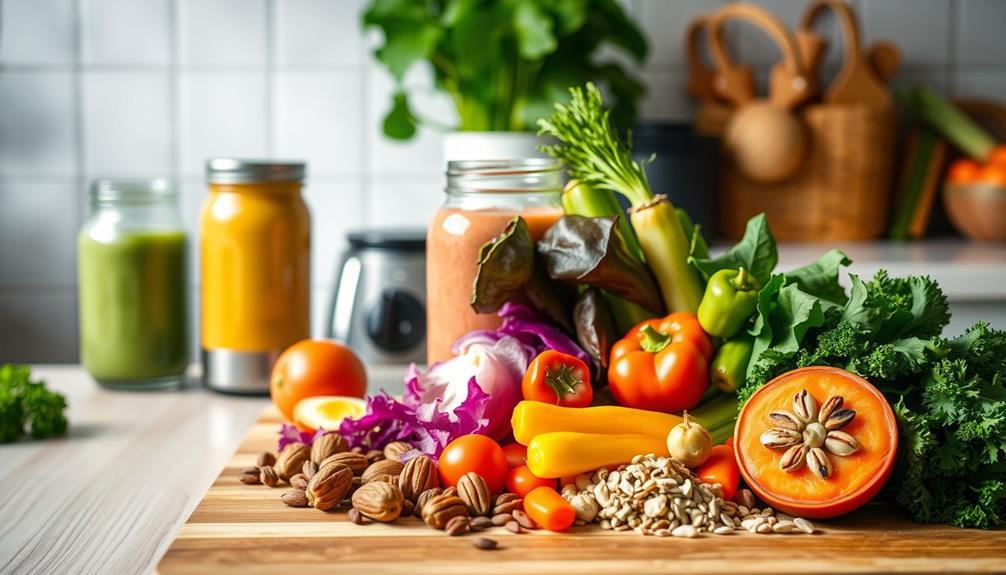
Meal preparation in a raw food diet can be both fun and rewarding, allowing you to create vibrant dishes that cater to everyone's tastes. Start by preparing one meal that satisfies your entire family. This approach streamlines cooking time and accommodates various dietary preferences, with options for adding cooked meats or grains if desired.
Incorporating a variety of raw ingredients can enhance nutrient absorption and promote digestive health, which is essential for a balanced diet. To explore the benefits of raw foods, consider nutritional advantages when planning your meals.
To make the most out of your raw vegan meals, experiment with different raw food combinations. Mixing unique flavors and textures can enhance your overall enjoyment. Use easily accessible ingredients like fresh fruits, vegetables, nuts, and seeds to guarantee a balanced and nutrient-dense diet.
Incorporate simple preparation methods such as juicing, blending, and dehydrating. These techniques highlight the freshness of raw ingredients and result in visually appealing dishes that everyone will love.
Don't forget to plan your meals in advance. This minimizes food waste and keeps your meals exciting and diverse. Continuously explore new raw foods and recipes to keep your culinary journey fresh and enjoyable.
Health Benefits and Risks
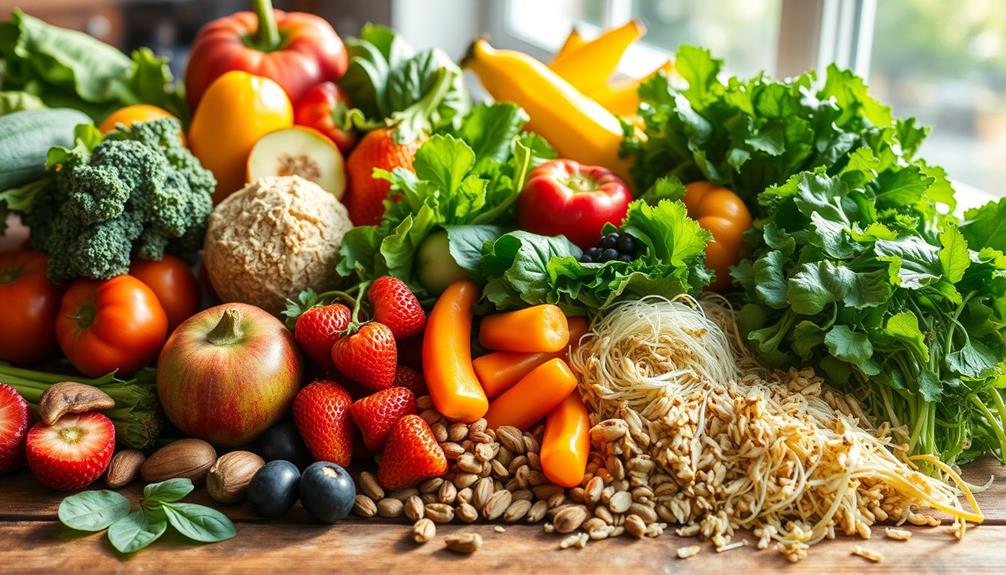
The raw food diet offers a range of health benefits, such as increased intake of essential vitamins, minerals, and antioxidants. By embracing raw foods, you may improve digestion and lower your risk of chronic diseases like heart disease and diabetes.
Additionally, incorporating natural remedies alongside conventional medications can enhance overall health. However, it's important to be aware of potential risks associated with this diet.
- Nutrient Deficiencies: You might face deficiencies in vitamin B12, calcium, and iron, as some nutrients are more absorbable when cooked.
- Weight Loss: While many experience weight loss due to lower calorie density, excessive restriction can lead to underweight status and disordered eating patterns.
- Digestive Discomfort: As your body adjusts to higher fiber intake, you could experience digestive discomfort during the initial phase.
Proper food handling and preparation are essential to reduce the risk of foodborne illnesses like salmonella and E. coli.
Balancing the health benefits of raw foods with awareness of these risks will help you make informed choices as you consider this diet.
Sample Menu and Ideas
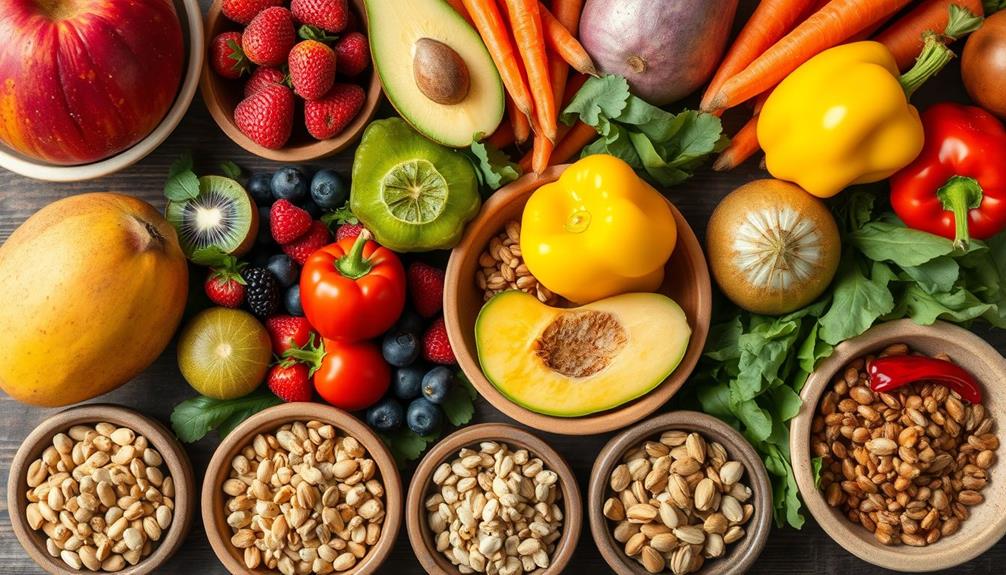
With a better understanding of the health benefits and risks of the raw food diet, it's time to explore some delicious and nutritious menu ideas.
For breakfast, whip up a smoothie using fresh fruits like bananas and berries, blended with leafy greens like spinach or kale for an extra nutrient boost. Incorporating a variety of raw nuts can add healthy fats and protein to your meals, enhancing the overall nutritional value of your diet. Consider trying numerous varieties available to excite your taste buds.
For lunch, create a colorful salad featuring raw vegetables such as tomatoes, bell peppers, and cucumbers, topped with unroasted raw nuts. Drizzle it with a dressing made from olive oil and lemon juice for added flavor.
When it's snack time, reach for fresh fruits like apples or pears, or enjoy raw nut bars made from blended nuts and dried fruits for a satisfying treat.
For dinner, try zucchini noodles tossed with a raw tomato sauce, blending tomatoes, garlic, and fresh herbs for a revitalizing dish.
Frequently Asked Questions
What Are Some Examples of Raw Foods?
When you think of raw foods, consider fresh fruits like apples and berries, crunchy vegetables such as carrots, and nutritious nuts and seeds. Exploring edible weeds and superfoods can also enhance your raw food experience.
What Foods Are Allowed on a Raw Food Diet?
Think of a vibrant rainbow; that's what your plate can look like on a raw food diet. You'll enjoy fresh fruits, crunchy veggies, nuts, seeds, and sprouted grains, all packed with nutrients and flavor.
What Counts as Raw Food?
Raw food counts as unprocessed, uncooked items like fresh fruits, vegetables, nuts, and seeds. You'll find they retain their natural nutrients and enzymes, offering health benefits you can't get from cooked or processed foods.
What Does Complete Raw Food Mean?
Complete raw food's like a vibrant garden, untouched by heat or additives. It means enjoying fresh fruits, veggies, nuts, and seeds, preserving their nutrients and enzymes, fueling your body with pure, unprocessed energy for peak health.
Conclusion
Incorporating raw foods into your diet can be an invigorating adventure that opens your taste buds to new flavors and textures. From common staples to unique superfoods, there's a world of vibrant ingredients waiting for you. Just remember, like a garden that needs care, your body thrives on variety and balance. Embrace the health benefits while being mindful of the risks. So go ahead, explore, and make your meals a colorful canvas of raw goodness!

